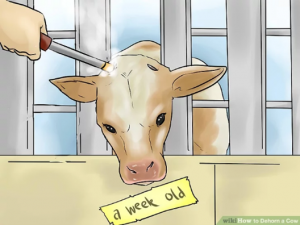
Did you know the milk you drink may well come from cows that have been dehorned with a hot iron? Horns? Hot iron? Ouch! Many people are surprised to learn that nearly all dairy cows, which come from the Holstein breed, are born with tissue that grows into horns. Horn-forming tissue is often removed by farmers from the cows’ skulls with chemicals or a hot iron to protect farmers, animal handlers and other cows. This process is painful, stressful and time-consuming, and requires expertise and pain control. In Canada, the NFACC Code of Practice for the Care and Handling of Dairy Cattle requires all calves to be disbudded to avoid injuries and behavioural problems associated with horns in later life. It reflects current dairy management practices such as disbudding calves before three weeks of age, adequately restraining the calf, using an appropriate method for the size of horn and/or age of animal, ensuring only trained persons carry out disbudding/dehorning procedures and using a combination of sedatives, local anesthetics and analgesics.
However, according to the scientific committee revising the Code of Practice, “disbudding/dehorning without pain mitigation” is one of “the most contentious practices” (along with early cow-calf separation, tail docking, culling of male dairy calves, and zero-grazing [lack of pasture access] and/or tie-stall housing systems). These results align with the surveys showing that 27-31% of Canadian producers say they always use pain killer for dehorning. However, 14-23% of producers indicate that using pain killers depends on age and method of dehorning.
Thus, another question might be: what if scientists could create hornless Holsteins just by changing the “gene for horns” to the one found in the naturally hornless Angus breed? Would they improve animal welfare by reducing pain? Or are they just using animals as mere objects to serve human purposes?
CRISPR Cas9 (CRISPR) is a breakthrough in biology with gene-editing applications for plants, animals and humans. Gene-editing, as one of the newest tools of biotechnology, can be a win-win for the animal and the producer. It’s also expected to have a positive influence on public opinion regarding the use of the technology in animal products due to its wide range of benefits (dehorning is just one). While consumers showed that they are more likely to accept gene-edited products than those from genetic modification (GM) or transgenesis, most people don’t understand what gene editing is. So how can they make a decision to buy it?
THE MOVE TOWARDS TRANSPARENCY
The lack of transparency is one of the greatest obstacles to the progress of gene-editing technology. For example: you need milk so you go to the grocery store. One jug is labeled “natural” and the other “genetically edited”. Which one do you choose? Regardless of price and origin, you probably feel more comfortable drinking “natural” milk. However, almost nothing we eat is truly “natural”.
Even though you may not realize it, more than 75% of food products sold in Canadian grocery stores can contain some GM ingredients but labels don’t mention it, says Sylvain Charlebois, senior director of the agri-food analytics lab and a professor in food distribution and policy at Dalhousie.
Moreover, some Canadians with an appetite for salmon may have already consumed the world’s first GM food animal without even knowing it, according to Sarah Cox, an award-winning journalist and author based in Victoria, BC. Along a similar line, people who support organic agriculture are convinced that plants are grown without chemicals. That’s not true. Even if people know about them, their belief system—that these are dangerous chemicals—kicks in.
How will Canadians react to gene-edited foods? Will they embrace this technology? According to Stuart Smyth, an assistant professor at the University of Saskatchewan’s department of Agricultural and Resources Economics, more than 90% of the Canadian public has no awareness about what technologies are used to develop plant varieties right now.
WE MUST OVERCOME THE FEAR OF GENETIC ENGINEERING IN OUR FOOD
Habits are hard to break. Researchers aren’t going to talk to people about the CRISPR Cas9 protein or a piece of RNA that’s skewing their viewpoints. We prefer to focus on what might work better instead. How’s that as a good starting point for a reasoned discussion? Talking can become very easy if we focus on specific benefit messages to increase consumer acceptance of gene-edited foods rather than on technical explanations.
For instance, when consumers have a close relationship with the trait or benefit itself, they are more likely to be interested in the technology; they’ll want to learn more and they’ll be more open to accept it, says Ian Affleck, vice-president of plant biotechnology at Ottawa-based CropLife Canada, a trade association representing plant science companies.
But the most important question is whether gene-edited foods can still be called natural products. There’s no reason at the moment to expect they will be any less of a concern to consumers than other genetically engineered foods.
Niloofar Pejman
Visiting Scientist, Livestock Gentec

